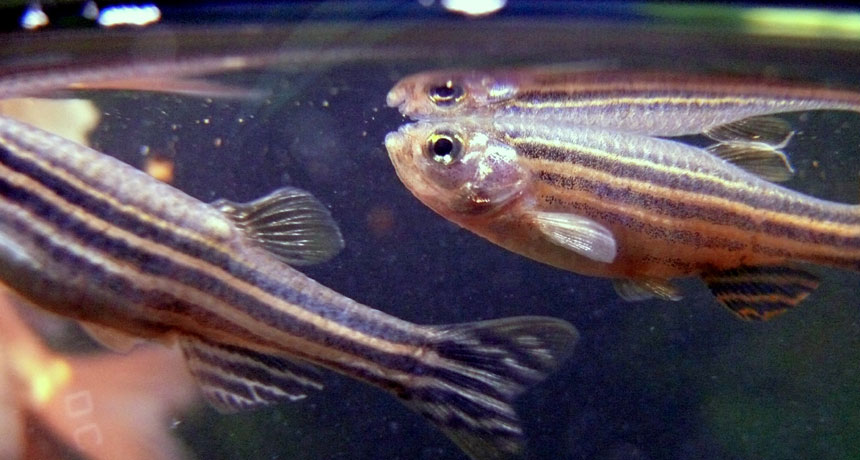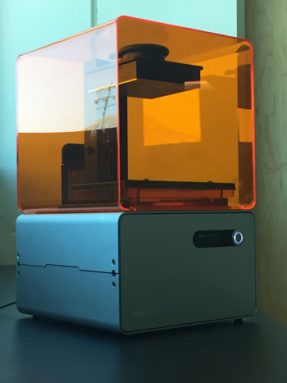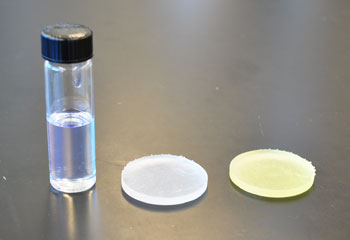Some 3-D printing can leave toxic taint
Freshly printed plastic parts may contain dangerous chemicals

Adult zebrafish make good research subjects because their eggs hatch in just three days. Also, eggs and developing fish are transparent, so their internal development is easy to observe.
Pogrebnoj-Alexandroff/Wikimedia Commons (CC BY-SA 3.0)
Today, it seems that three-dimensional, or 3-D, printers are everywhere. People use them in labs, schools —even at home. Anyone can draw an object using a computer program and then print it out of plastic. But some newly printed plastics may emerge with traces of dangerous chemicals, a new study finds. The good news: There also appears to be a cure for the problem.
Shirin Oskui is a bioengineer at the University of California, Riverside. The lab where she works develops tools to measure very small things. She needed a way to measure tiny zebrafish eggs and newly hatched baby fish. So Oskui designed and made a tool using a 3-D printer.
She immersed her tool in a dish with zebrafish eggs. The eggs were just about to hatch. But to her surprise, many eggs never did. And fish that did were sick.Oskui was surprised. Her lab regularly hatches zebrafish inside plastic Petri dishes. That plastic labware has never harmed her fish. This suggested that “it’s not plastic that’s the villain here,” says William Grover. He is also a bioengineer at UC Riverside. Grover and Oskui investigated further. They discovered that processes inside some 3-D printers can leave traces of toxic chemicals on the finished object.
The research team published its new findings online November 4 in Environmental Science & Technology Letters.
How they learned what went wrong
Oskui and Grover tested two 3-D printers. Each printer used a different plastic “ink” and a different process to build objects.
One printer works in a way similar to a hot glue gun. It takes in solid plastic, melts it, forms it into a shape, then cools it back into a solid. The plastic that goes in is the same plastic that comes out.

The researchers made three small disks with each printer. Afterward, they placed each disk into its own dish along with 30 newly laid zebrafish eggs. As a control, they also placed zebrafish eggs in dishes with no plastic disks. The team monitored the eggs to see how many hatched and how any baby fish developed.
About 80 percent of fish in the control groups survived for at least a week and developed normally. Fish in dishes with disks from the hot-glue-gun printer had some health problems, and only about 60 percent survived. However, every fish in the remaining dishes died.
Those eggs and hatchlings had been exposed to plastic made by stereolithography. The final, printed object comes out coated in its liquid ink. Oskui and Grover followed the printer’s directions to clean the finished object. But even then traces of the liquid likely remained. That liquid could be what poisoned the fish, the researchers suspect.

To test that, she put the finished objects under the same ultraviolet light as the printer’s laser had used. After one hour, any liquid still stuck to the part had become solid. When Oskui’s team submerged these disks in water with the fish eggs, more than 60 percent of the fish survived at least a week.
“3-D printers are awesome,” says Grover, but we need to make sure that we are using them safely. Big factories that manufacture plastic Petri dishes or cups or spoons have to follow strict rules for safety and cleanliness. A 3-D printer is a factory “shrunk down into a little box,” he explains. It may be doing the same chemistry as a big factory, but it may not follow the same procedures meant to keep commercial products safe.
Grover hopes that researchers will focus not only on how to do 3-D printing, but also on how to ensure the safety of printed objects. Additional research might reveal whether any of these parts could pose risks to people or the environment.
James Meador was not involved in the research. As a toxicologist, he studies the effects of contaminants on fish at the National Oceanic and Atmospheric Administration’s Northwest Fisheries Science Center in Seattle, Wash. Zebrafish eggs in this study were likely exposed to a very high concentration of chemicals, he notes. If parts from a 3-D printer fell into a lake or river, the toxic residues would spread out, or become diluted. This would make them less dangerous, he says. However, he adds, the toxicity seen here is “definitely a cautionary tale and deserves additional study.”
Both Grover and Meador agree that parts from most 3-D printers should be perfectly safe to touch. However, don’t print out a spoon and use it to eat breakfast, they warn. And definitely don’t print a castle for your pet zebrafish!
Power Words
(for more about Power Words, click here)
bioengineer Someone who applies engineering to solve problems in biology or in systems that will use living organisms.
chemical A substance formed from two or more atoms that unite (become bonded together) in a fixed proportion and structure. For example, water is a chemical made of two hydrogen atoms bonded to one oxygen atom. Its chemical symbol is H2O. Chemical can also be an adjective that describes properties of materials that are the result of various reactions between different compounds.
chemical reaction A process that involves the rearrangement of the molecules or structure of a substance, as opposed to a change in physical form (as from a solid to a gas).
chemistry The field of science that deals with the composition, structure and properties of substances and how they interact with one another. Chemists use this knowledge to study unfamiliar substances, to reproduce large quantities of useful substances or to design and create new and useful substances. (about compounds) The term is used to refer to the recipe of a compound, the way it’s produced or some of its properties.
commercial (in research and economics) An adjective for something that is ready for sale or already being sold.
contaminant Pollutant; a chemical, biological or other substance that is unwanted or unnatural in an environment such as water, soil, air, or food. Some contaminants may be harmful in the amounts at which they occur or if they are allowed to build up in the body over time.
control A part of an experiment where there is no change from normal conditions. The control is essential to scientific experiments. It shows that any new effect is likely due only to the part of the test that a researcher has altered. For example, if scientists were testing different types of fertilizer in a garden, they would want one section of it to remain unfertilized, as the control. Its area would show how plants in this garden grow under normal conditions. And that give scientists something against which they can compare their experimental data.
dilute To make something thinner or less concentrated by adding a liquid to it.
environment The sum of all of the things that exist around some organism or the process and the condition those things create for that organism or process. Environment may refer to the weather and ecosystem in which some animal lives, or, perhaps, the temperature, humidity and placement of components in some electronics system or product.
laser A device that generates an intense beam of coherent light of a single color. Lasers are used in drilling and cutting, alignment and guidance, in data storage and in surgery.
National Oceanic and Atmospheric Administration, or NOAA A science agency of the U.S. Department of Commerce. Initially established in 1807 under another name (The Survey of the Coast), this agency focuses on understanding and preserving ocean resources, including fisheries, protecting marine mammals (from seals to whales), studying the seafloor and probing the upper atmosphere.
Petri dish A shallow, circular dish used to grow bacteria or other microorganisms.
stereolithography A process that some 3-D printers use to form objects. In the process, light triggers a chemical reaction that changes a liquid into a solid.
toxic Poisonous or able to harm or kill cells, tissues or whole organisms. The measure of risk posed by such a poison is its toxicity.
three-dimensional (3-D) printer A machine that takes instructions from a computer program on where to lay down successive layers of some raw material to create a three-dimensional object.
three-dimensional (3-D) printing The creation of a three-dimensional object with a machine that follows instructions from a computer program. The computer tells the printer where to lay down successive layers of some raw material, which can be plastic, metals, food or even living cells. 3-D printing is also called additive manufacturing.
toxicologist A scientist who studies poisons and how they disrupt the health of people and other organisms.
ultraviolet A portion of the light spectrum that is close to violet but invisible to the human eye.
zebrafish A small tropical freshwater fish belonging to the minnow family. Zebrafish are used frequently in scientific research because they grow quickly and their genetic makeup is well understood.







